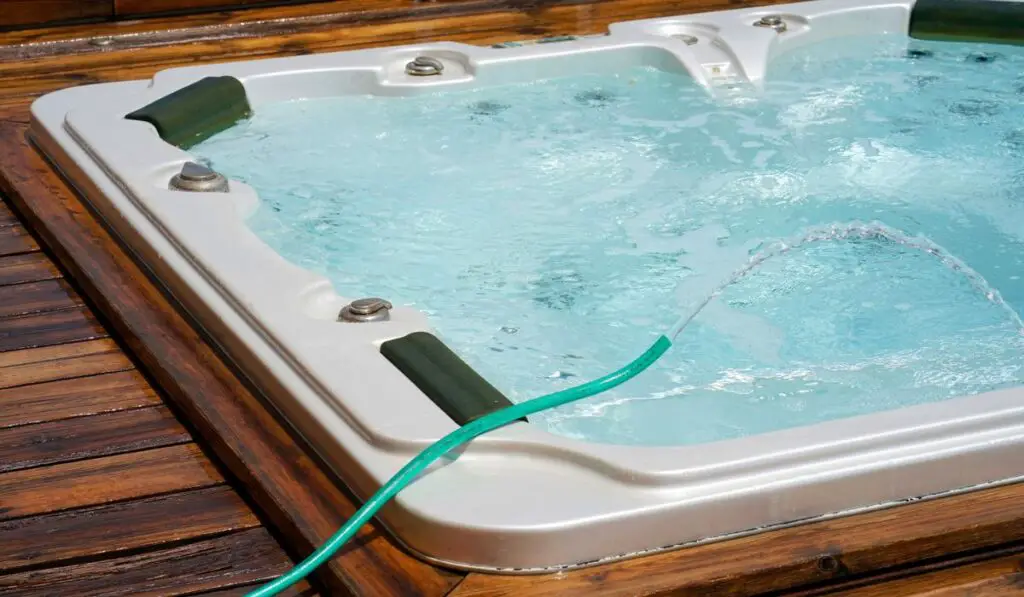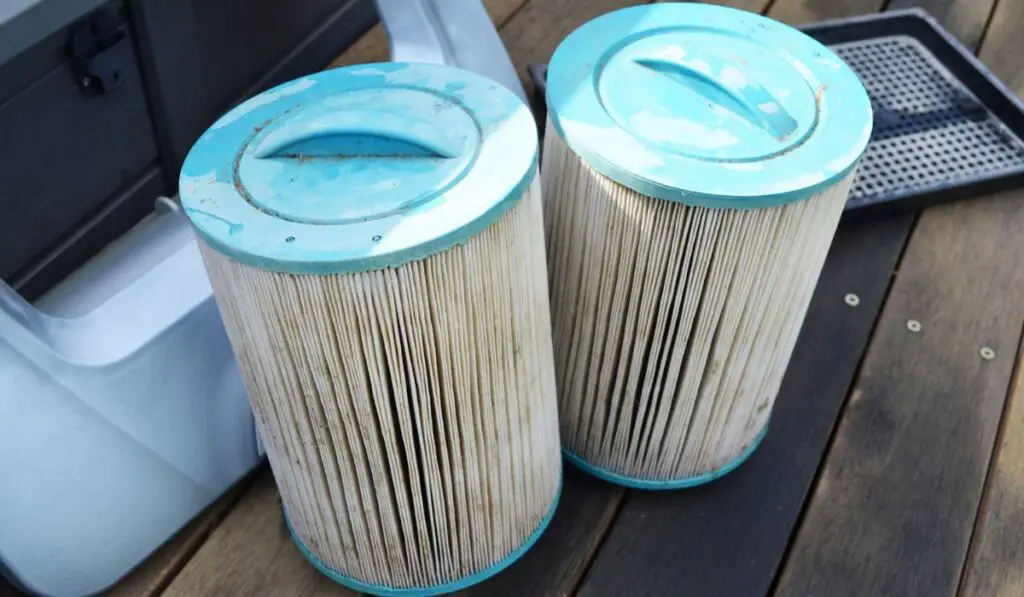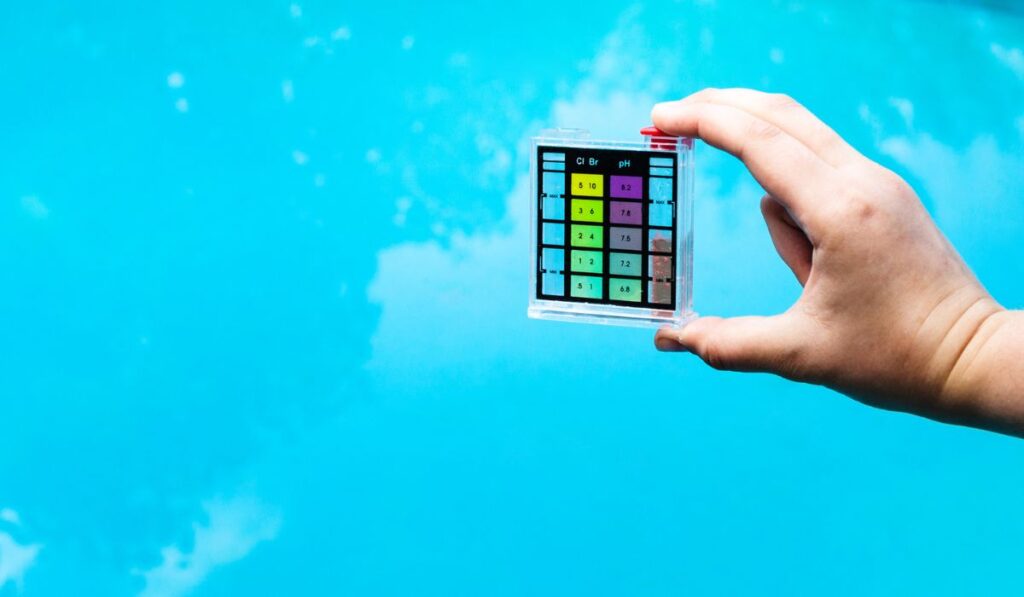Having a hot tub in your house is a luxury that can make even the coldest winters a bit more bearable. But how much time and money do you have to spend on hot tub maintenance? And how do you keep the tub’s water hygienic?
Hot tubs require daily routine checks, light weekly cleaning, and more thorough monthly cleaning. Use an inexpensive water test kit to monitor pH, chlorine, alkalinity, and water hardness levels. Clean the filters regularly, and plan to partially drain and refill the hot tub every once in awhile.
Let’s look at the basics of hot tub water treatment, how to test your water, and what you need to do maintain your hot tub properly.
Are Hot Tubs High Maintenance?

Hot tubs aren’t exactly high maintenance, but they do require an understanding of the basics of tub maintenance, water maintenance, and cleaning techniques. You can easily maintain a hot tub if you follow a regular maintenance schedule. Hot tubs only become harder to clean if you don’t maintain them for a long time.
Hot tubs don’t cost much to maintain either. If you follow a proper cleaning schedule, you can maintain a hot tub for less than $20 a month. Although you’ll need to spend more initially to invest in some testing equipment, the only month-to-month costs are the cleaning chemicals.
We’ll discuss some test strips below that are much less expensive. If you are managing your pool and hot tub without the help of a professional, you may want a more robust test kit like the TAYLOR K-2006 Complete Swimming Pool/Spa Test Kit (on Amazon). This will give you all the options you need for diagnosing chemical issues and running the daily or weekly tests you choose to prioritize.
If you follow a proper daily, weekly, and monthly maintenance schedule, you’ll never have to worry about a dirty hot tub — and there’s less chance of your hot getting damaged. Most of the latest hot tubs are made from material that’s easy to clean and won’t wear away easily, so you won’t have to worry about paying for regular hot tub repairs.
The type of hot tub you have will also affect how much maintenance it needs. Larger spas and jacuzzis need more thorough maintenance since they’re more likely to be used at irregular intervals. However, if you use a hot tub daily, you won’t have to spend too much time on monthly maintenance.
Also, not all hot tubs have the same water maintenance systems. Hot tubs with more advanced systems require little to no manual maintenance, while older ones may need more regular cleaning.
We’ll go through the basics of hot tub maintenance that apply to most hot tubs. In most cases, the basics should be enough. However, if you aren’t sure if your hot tub has special maintenance requirements, you can check the maintenance schedule in the user manual or consult your local plumber.
How Do You Treat Hot Tub Water?
Treating your hot tub water is essential for preventing waterborne diseases, skin irritations, and keeping dirt out of your hot tub. When treating your hot tub’s water, you’ll have to ensure that the water’s pH is balanced and that it remains clean.
You can do this by testing the water’s pH levels, using chemicals to clean dirt from the tub, and ensuring that the water is properly circulated.
Here are some essentials to consider when treating your hot tub’s water:
Maintain Proper Water Circulation
Before you can start treating your hot tub’s water, you’ll have to take steps to prevent the water from getting dirty in the first place. The easiest way to do this is to maintain proper water circulation since stagnant water is more likely to attract algae, insects, and dirt.
Water circulation systems in hot tubs ensure that the water is passed through the filters once or twice a day. Most hot tubs will have several filters to keep the water hygienic.
But how often should you turn on the hot tub’s circulation system?
If your hot tub has an automated circulation system, it will switch on automatically twice or three times daily. If not, make sure you run the circulation system at least once a day. Leave it on for around 20 minutes if you have an average-sized tub (more for larger hot tubs). This will ensure that all the water is thoroughly circulated through the filters.
Balance the Water’s pH
Like swimming pools, hot tubs need to have a balanced pH to prevent skin damage. You’ll need to test the water’s pH regularly and add acidic or alkaline solutions to balance it out. Always consult your hot tub user guide to check how to keep the water balanced and hygienic.
Many people recommend using a sanitizer to keep the hot tub’s water hygienic. You can also use a ‘shock,’ which is an oxidizer that keeps the water’s pH balanced and will prevent bacteria from breeding in the water.
Apart from the pH, you’ll also have to balance the water’s hardness, metal composition, and other factors.
However, you’ll only need to use most of these chemicals once a week or once a month. We’ll discuss monthly and weekly hot tub maintenance below.
Clean the Hot Tub’s Filters

Although the water filters in your hot tub do a great job of preventing your tub’s water from getting dirty, you’ll have to clean them regularly. There are various ways to clean a hot tub’s filter depending on how dirty it is.
Here are some ways to clean hot tub filters:
- Rinsing: You can clean the hot tub’s filters by rinsing them if they aren’t especially dirty.
- Using a Filter Cleaner: If you want to treat your hot tub’s filters more thoroughly, you can spray them with a filter cleaning chemical.
- Using a Stronger Chemical Cleaner: If you’re cleaning your hot tub’s filters and they’re extremely dirty, you can soak them in a chemical cleaner to remove dirt and germs. Always rinse the filters after soaking them in a chemical solution.
Which method you use will depend on how dirty the filters are and how often you clean them. However, there’s no harm in using a chemical solution to clean your tub’s filters every time.
Daily vs. Weekly Maintenance
While there’s no doubt that regular hot tub maintenance will keep your tub’s water hygienic, you don’t have to drain and scrub it daily. It’s helpful to stick to a daily, weekly, and monthly maintenance schedule, so you don’t have to go overboard with maintenance at any one point.
So, what should you do to maintain your hot tub daily, and what should you include in a weekly maintenance schedule?
Daily Maintenance
Daily hot tub maintenance should take less than 5 minutes, and it will help prevent your tub from getting dirty over time. Daily maintenance includes the following:
- Switch on the water circulation system if your tub’s system is manual. If your hot tub has an automatic water circulation system, you can skip this step.
- Keep the water temperature balanced to prevent damage to the tub. Some hot tubs will adjust the water temperature automatically.
- Cover the hot tub after using it to prevent dirt, insects, and other animals from entering the water. Even if you don’t use the tub, just check that the cover is secured properly.
- Monitor the dsinfectant, whether it’s chlorine or bromine. This is the single most important parameter effecting your hot tub’s safety to occupants, so, figure out if you have a chlorine or bromine system, or something more exotic, and measure the chemical that shows it’s working daily or when it’s being used.
Weekly Maintenance
While daily maintenance will keep your hot tub clean, you’ll have to do more thorough maintenance once a week. Fortunately, even weekly maintenance shouldn’t take more than a couple of minutes. Here’s what to include in your weekly hot tub maintenance schedule:
- Test the water’s pH and alkalinity to ensure that the water’s chemistry is balanced. Use chemicals to balance the chemistry as needed.
- Add sanitizer to the water to keep it clean. You’ll only need to add a little sanitizer weekly to keep the water hygienic.
- Remove visible dirt and wipe any part of the hot tub that’s above the water. If you skip this step, you’ll have to do a lot of scrubbing at the end of the month!
- Rinse the hot tub filter or spray it with filter cleaner if needed.
Monthly Maintenance
The weekly maintenance will ensure the hot tub’s water is hygienic and the tub remains clean enough to use. However, you’ll have to spend some time cleaning your hot tub even more thoroughly once a month.
Here’s what to include in a monthly hot tub maintenance schedule:
- Clean the filters and jets thoroughly. You can soak the filters in a cleaning chemical and rinse them for a more thorough cleaning.
- Drain and scrub the hot tub. You can do this monthly or every few months, depending on how dirty your tub is.
- Check the tub for structural damage. Always check that your hot tub is working properly and look for signs of structural damage once a month. You can also have it checked by a professional.
How to Check Your Hot Tub’s Alkalinity
You’ll need a water testing kit to test your hot tub’s alkalinity. A simple litmus strip can be used, but some testing kits have advanced testing equipment to help measure the water’s alkalinity more accurately.
Follow these steps to test the water’s alkalinity:
- Read the instructions on the testing kit thoroughly.
- Take the test strip and place it in the tub’s water.
- Compare the strip’s color with the code given in the test kit’s manual.
- Add acid or oxidizing agent as needed to increase or reduce the water’s alkalinity.
The ideal alkalinity range for hot tub water is between 80 and 120 PPM. Anything higher or lower means your water needs treatment.
How to Check Your Hot Tub’s PH Levels

Testing the water’s pH levels is just as important as testing the alkalinity. If the water is too acidic or alkaline, you’ll have to adjust it to prevent skin damage. You can use a simpler hot tub water test strip kit (on Amazon) to test the water’s pH levels.
Follow these steps to test the water’s pH:
- Check how to read the testing strips in the kit’s instructions.
- Place the testing strips inside the hot tub’s water.
- Check the change in color and correspond it with the testing kit indicators.
- If the water is too basic, you can add acid to balance it out. If it’s too acidic, you can use an oxidizer or other pH-increasing solution.
The ideal pH for hot tub water is 7.2-7.8. Anything lower than this means that the water is too acidic.
Determining Your Water Hardness
Water hardness is a key factor to check for when maintaining your hot tub’s water. If the water is too hard, it will become cloudy, and it isn’t great for your skin. Water that’s too soft can also be problematic.
To test water hardness, you’ll need an advanced water testing strip or testing kit. The ideal water hardness is around 200 PPM, but you don’t have to worry even if the hardness goes up to 400 PPM. This is because slightly more calcium in the water won’t cause major issues immediately.
The real problem is when the water hardness is too low, as this indicates a lack of calcium in the water. Water that’s too soft is more corrosive and may damage your hot tub. So, if the hardness is below 170 PPM, you’ll need to increase it.
You can add calcium to the water with a calcium hardness increaser or other chemicals designed to increase the water’s hardness. If you have water that’s too hard, you can use water clarifying agents to balance the water’s calcium levels.
What Products Do I Need to Clean My Hot Tub?
Cleaning your hot tub is essential to preventing structural damage, keeping the water hygienic, and preventing dirt build-up in the tub. Fortunately, most hot tub cleaning chemicals are easy to find and relatively cheap.
Here’s what you need for proper hot tub maintenance:
- Spray Surface Cleaner (on Amazon): This is ideal for weekly cleaning and removing dirt from the tub part that’s above the water level.
- Scrubbing Brush (on Amazon): You can use any scrubbing brush but avoid ones that are too hard as they may damage the tub.
- Water Sanitizer (on Amazon): This oxidizing agent is essential for keeping germs out of the hot tub and increasing the water’s oxygen levels.
- pH Increaser (on Amazon): Use this when the water is too acidic.
- pH Decreaser (on Amazon): While you could issue vinegar and other acids to the same job, this pH decreaser is safer for your skin.
- Calcium Hardness Increaser (on Amazon): You may only have to use this once a month or once every few months, but it’s part of the essentials.
If it’s your first time buying cleaning supplies for your hot tub, you may have to invest a little upfront. However, most of these cleaning materials will last several months, so the actual monthly maintenance cost is pretty minimal.
